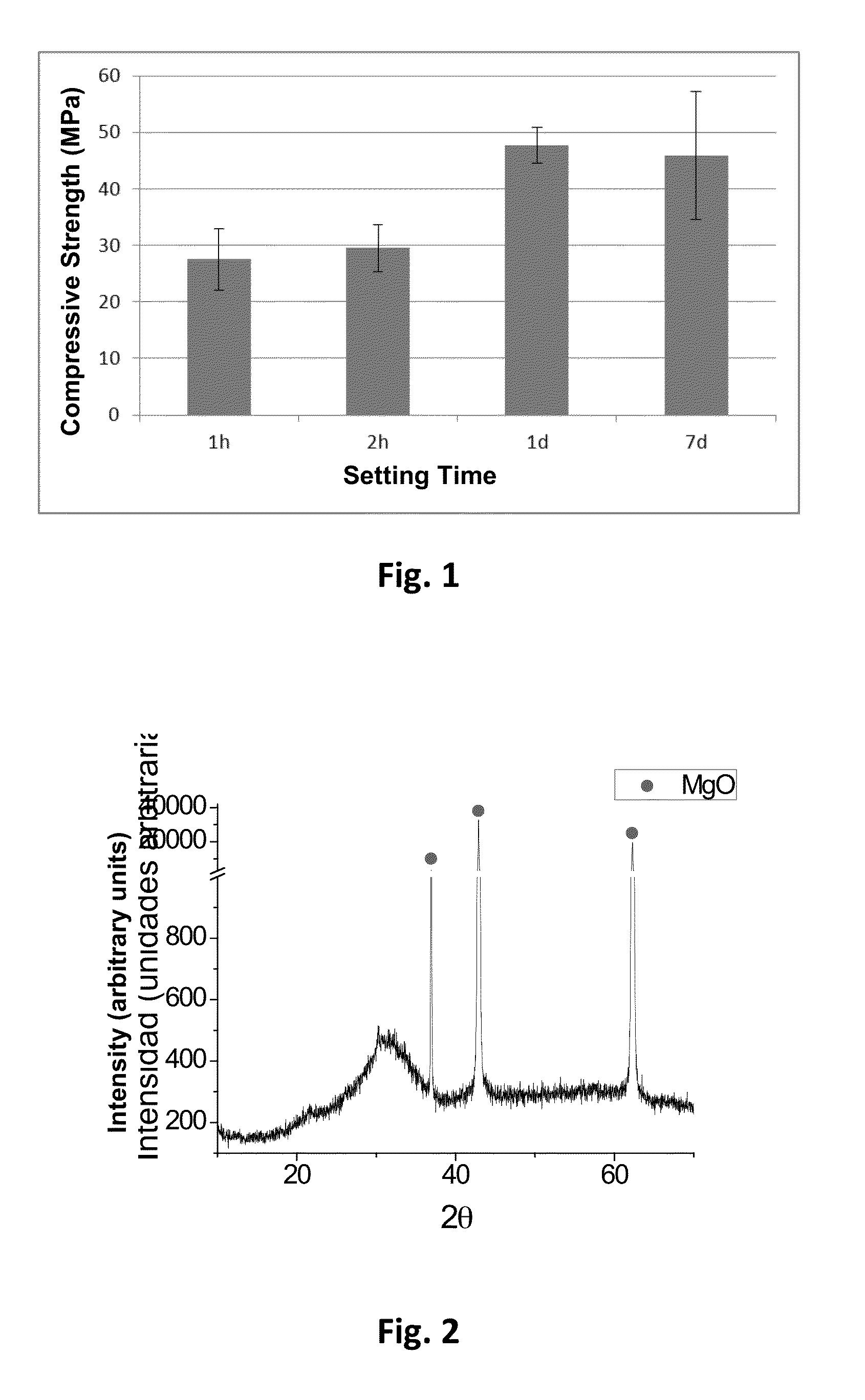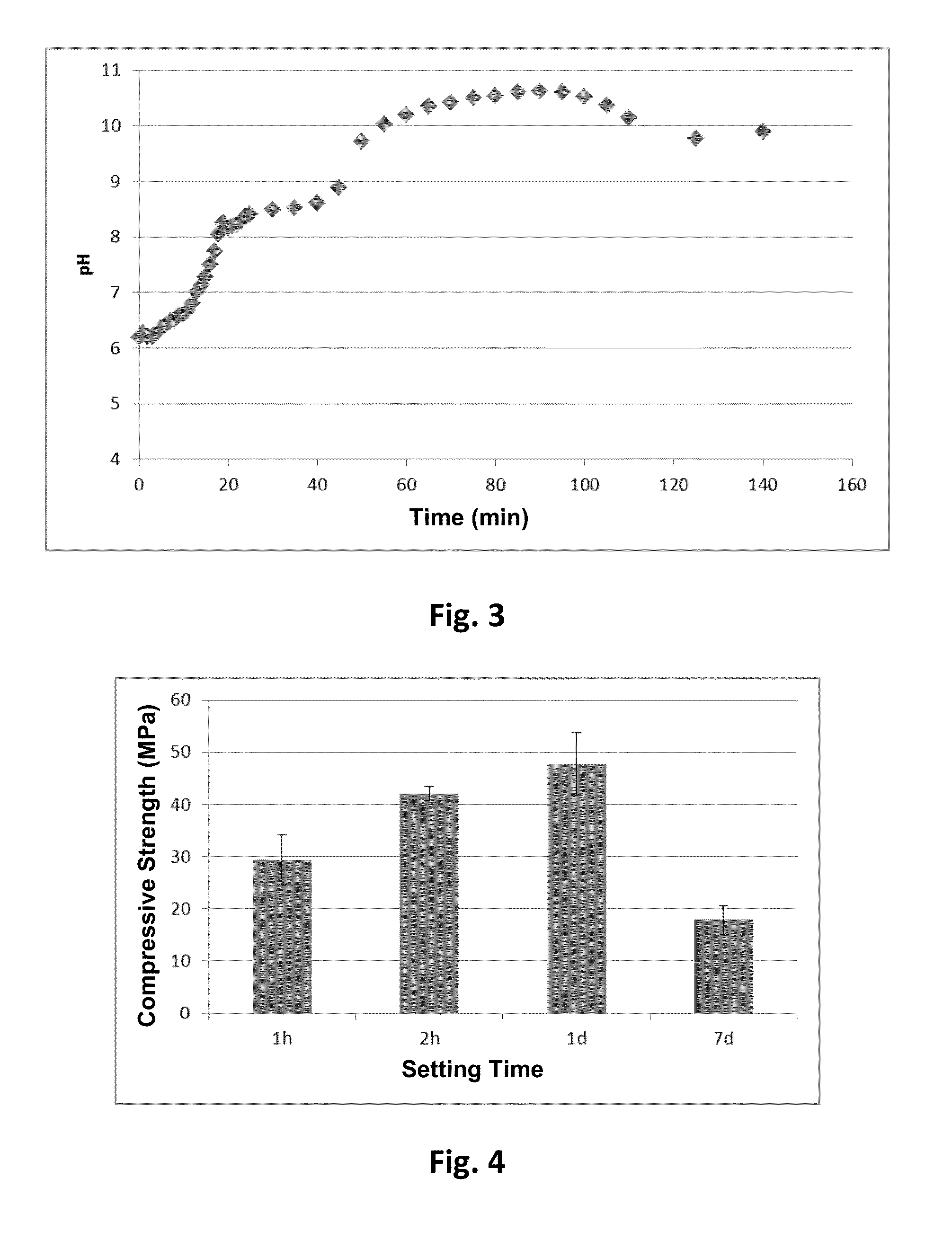Inorganic Cement for Biomedical uses, Preparation Method Thereof and Use of Same
a biomedical and cement technology, applied in the field of biomaterials, can solve the problems of uncertain limitations, slow setting and hardening reaction, poor mechanical properties,
- Summary
- Abstract
- Description
- Claims
- Application Information
AI Technical Summary
Benefits of technology
Problems solved by technology
Method used
Image
Examples
example 1
[0032]Magnesium phosphate cement prepared based on magnesium oxide, sodium hydrogen phosphate and borax
[0033]50 g of MgO calcined at 1475° C. for 6 h were ground in an agate jar by means of using 4 agate balls, a planetary mill and grinding conditions of 150 rpm for 15 min. The same process was performed separately for NaH2PO4 and borax. 25 g of MgO were mixed with 19.584 g of NaH2PO4 and 1.379 g of borax in a homogeniser for 20 min. The preparation of the paste consisted of mixing 1.5 g of powder with 195 μL of water, and it was homogenised for 1 min to yield a paste with good consistency.
[0034]The initial and final setting time were measured by means of the Gillmore needle test [18], according to which the initial setting time is defined as the time taken from the moment the powder contacts the liquid until a pressure of 0.3 MPa leaves no mark on the surface of the cement; and the final setting time as the time elapsed from the moment the powder contacts the liquid until a pressur...
example 2
[0037]Evolution of the pH produced by a magnesium sodium phosphate powder.
[0038]Calcined MgO powder with a particle size between 0.1 and 40 μm and a specific surface area of 0.63 m2 / g, and NaH2PO4 powder with a particle size between 100 and 500 μm and a specific surface area of 0.07 m2 / g were mixed with a MgO:NaH2PO4 molar ratio of 3.8:1.
[0039]A saturated solution of the cement was prepared by mixing the powder mentioned in the preceding paragraph with water at a liquid / powder ratio of 10 mL / g, and the evolution of pH over time was measured. Said process was reported by Serraj [12] as an indirect method for evaluating the antimicrobial effect of a cement due to the basicity produced in its environment.
[0040]FIG. 3 shows how a saturated solution of magnesium sodium phosphate powder makes pH rapidly increase, giving pH close to 9.5 in only 20 min and reaching pH greater than 10.5 in 90 min. It is known that microbes are sensitive to pH values higher than 9.5, accordingly this pH is su...
example 3
[0041]Magnesium phosphate cement prepared based on magnesium oxide, sodium hydrogen phosphate, ammonium hydrogen phosphate and borax
[0042]50 g of MgO calcined at 1475° C. for 6 h were ground in an agate jar by means of using 4 agate balls, a planetary mill and grinding conditions of 150 rpm for 15 min. The same process was performed separately for NH4H2PO4, NaH2PO4 and borax. 25 g of MgO were mixed with 9.388 g of NH4H2PO4, 9.792 g of NaH2PO4 and 1.484 g of borax in a homogeniser for 20 min. The preparation of the paste consisted of mixing 1.5 g of powder with 195 μL of water, and it was homogenised for 1 min to yield a paste with good consistency.
[0043]The initial and final setting time was measured by the Gillmore needle test as described in Example 1. The test was performed by introducing the cement paste into plastic cylindrical moulds 10 mm in height. The initial setting time of the cement was 11.5 min, and the final time was 13 min.
[0044]The exothermic nature of the cement was...
PUM
| Property | Measurement | Unit |
|---|---|---|
| molar ratio | aaaaa | aaaaa |
| temperatures | aaaaa | aaaaa |
| size | aaaaa | aaaaa |
Abstract
Description
Claims
Application Information
 Login to View More
Login to View More - R&D
- Intellectual Property
- Life Sciences
- Materials
- Tech Scout
- Unparalleled Data Quality
- Higher Quality Content
- 60% Fewer Hallucinations
Browse by: Latest US Patents, China's latest patents, Technical Efficacy Thesaurus, Application Domain, Technology Topic, Popular Technical Reports.
© 2025 PatSnap. All rights reserved.Legal|Privacy policy|Modern Slavery Act Transparency Statement|Sitemap|About US| Contact US: help@patsnap.com


